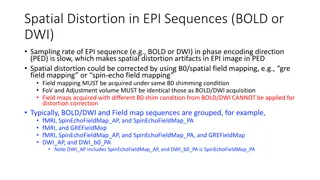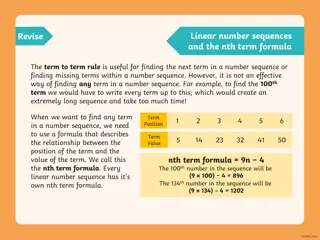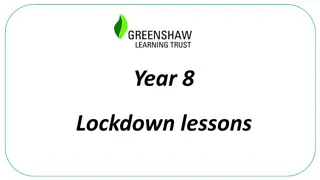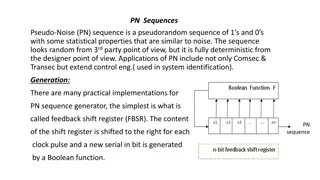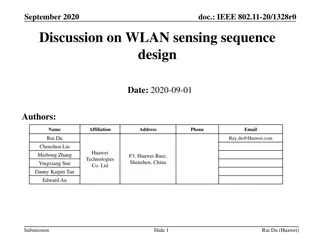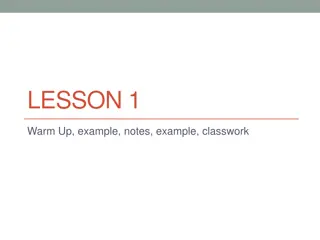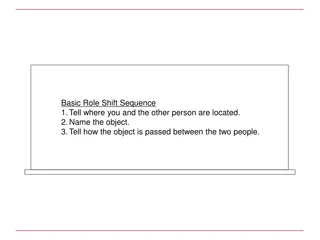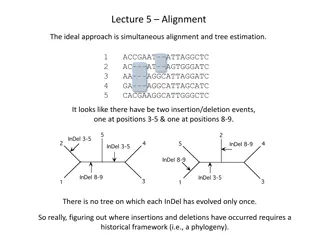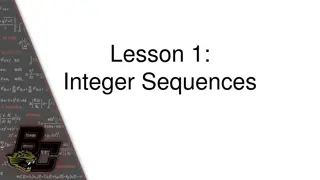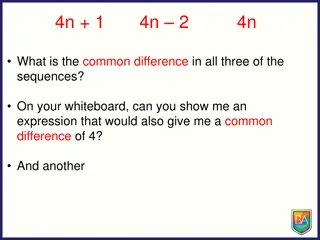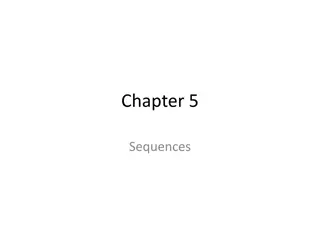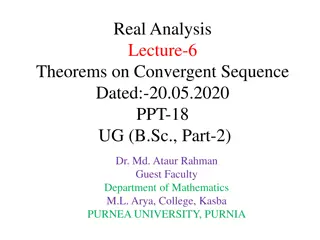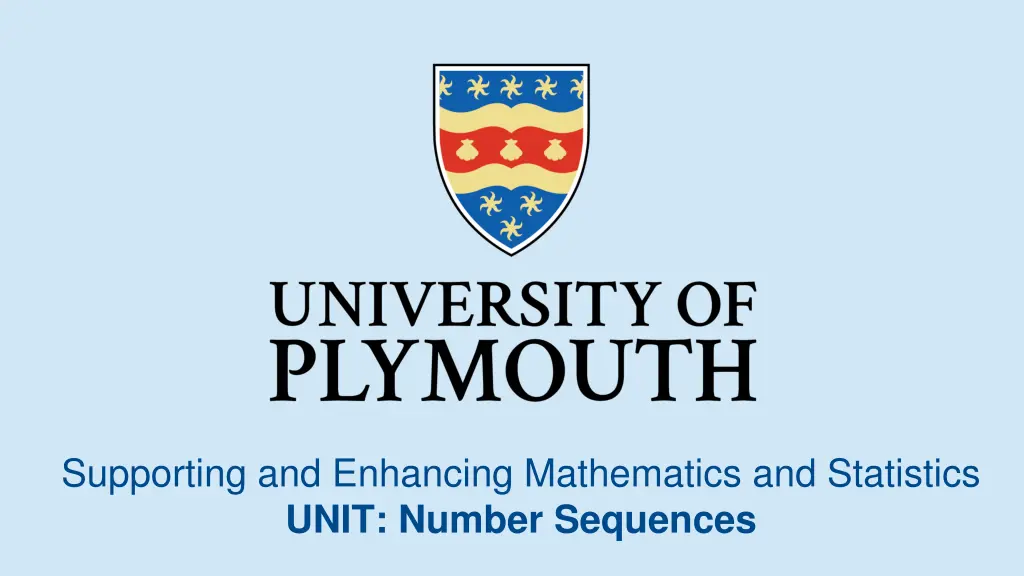
Enhancing Mathematics and Statistics Through Number Sequences
Explore the fascinating world of number sequences in mathematics and statistics, covering simple patterns, recognizing different patterns like Fibonacci and Square Numbers, with interactive exercises and tests to boost your skills.
Download Presentation

Please find below an Image/Link to download the presentation.
The content on the website is provided AS IS for your information and personal use only. It may not be sold, licensed, or shared on other websites without obtaining consent from the author. If you encounter any issues during the download, it is possible that the publisher has removed the file from their server.
You are allowed to download the files provided on this website for personal or commercial use, subject to the condition that they are used lawfully. All files are the property of their respective owners.
The content on the website is provided AS IS for your information and personal use only. It may not be sold, licensed, or shared on other websites without obtaining consent from the author.
E N D
Presentation Transcript
Supporting and Enhancing Mathematics and Statistics UNIT: Number Sequences
Number Sequences UNIT: Number Sequences Number Sequences are an important part of algebra work. You have four sections to work through and there are check up audits and fitness tests for each section. 1. Simple Number Patterns 2. Recognising Number Patterns 3. Extending Number Patterns 4. Formulae for Number Sequences
Simple Number Patterns UNIT: Number Sequences Section 1 A list of numbers which form a pattern is called a sequence. To continue a number sequence, it is often very useful to look for the difference between numbers. Sequence Difference 7, 11, 15, 19, 23, 4 4 4 4 In this sequence, the difference is 4. The next two terms are: 7, 11, 15, 19, 23, 27, 31, 23 + 4 = 27 and 27 + 4 = 31, giving
Section 1: Fitness Check UNIT: Number Sequences Section 1 Here are some questions to check your progress; there are more practice questions if needed. Find the next four numbers in each sequence. 4, 9, 14, 19, 24, 29, 34, 39 3, 20, 37, 54, 71, 88, 105, 122 15, 17, 19, 21 7, 9, 11, 13, 9, 18, 27, 36 18, 9, 0, 2, 2.25, 2.5, 2.75, 3, 3.25, 3.5, 3.75 1.9, 3.3, 4.7, 6.1, 7.5, 8.9, 10.3, 11.7 14 5, 21 5, 23 1 5, 3 5, 1, 12 5 , 3 5, 0.63, 0.56, 0.49, 0.42 0.91, 0.84, 0.77, 0.7,
Section 1: Review UNIT: Number Sequences Section 1 You have completed the first Section. If you have completed and understood this section, click to start the next Section If you need more examples and interactive practice, press here You might also find it helpful to look at: Essential Information: press here
Recognising Number Patterns UNIT: Number Sequences Section 2 Some number sequences follow different patterns. Look at the ones below. Can you spot the patterns? 1, 1, 2, 3, 5, 8, 13, 21, 34, Fibonacci Sequence: Square Numbers: 1, 4, 9, 16, 25, 36, 49, Triangular Numbers: (Note: Two consecutive Triangular Numbers sum to a Square Number, for example: 10 + 15 = 25) 1, 3, 6, 10, 15, 21, 28, 36, ... Cube Numbers: 1, 8, 27, 64, 125, 216, ...
Recognising Number Patterns UNIT: Number Sequences Section 2 1, 1, 2, 3, 5, 8, 13, 21, 34, Fibonacci Sequence: is obtained by adding together two consecutive terms to obtain the next term. 1 + 1 = 2 1 + 2 = 3 2 + 3 = 5 3 + 5 = 8 and so on 1, 4, 9, 16, 25, 36, 49, Square Numbers sequence: is obtained by squaring 1, then squaring 2, then squaring 3, then squaring 4, then squaring 5, ... Triangular Numbers sequence: the difference increases by 1 each time, starting with +2, then +3, then +4, Cube Numbers sequence: is obtained by cubing 1, then cubing 2, then cubing 3, then cubing 4, then cubing 5, ... 12, 22, 32, 42, 52, 62, 72, 1, 3, 6, 10, 15, 21, 28, 36, ... 1, 8, 27, 64, 125, 216, ... 13, 23, 33, 43, 53, 63,
Recognising Number Patterns UNIT: Number Sequences Section 2 Number sequences sometimes require detective work. Often they are very similar to ones previously encountered - with just an added tweak or two. 2, 5, 10, 17, 26, 37, 50, Look at this one: What comes next? This is the square number sequence with one more added to each term. 2, 5, 10, 17, 26, 37, 50, 65, 82, And this one? This is the triangular number sequence with each term doubled. 2, 6, 12, 20, 30, 42, 56, 72, ... 2, 6, 12, 20, 30, 42, ... 1, 5, 6, 11, 17, 28, Try this one Similar to the Fibonacci sequence, this sequence is obtained by adding together two consecutive terms to obtain the next term.
Recognising Number Patterns UNIT: Number Sequences Section 2 Describe how the following sequences are related, and find the next term for each: a) 1, 1, 2, 3, 5, 8, 13, 21, b) 5, 5, 6, 7, 9, 12, 17, 25, c) 2, 2, 4, 6, 10, 16, 26, 42, The first is the Fibonacci sequence; the second is the Fibonacci sequence with 4 added to each term; the third is the Fibonacci sequence with each term doubled. 34 38 68 Find the next 2 terms in this number sequence: 1, 2, 7, 14, 23, 34, 47, 62 This is the square number sequence with 2 subtracted from each term.
Section 2: Fitness Check UNIT: Number Sequences Section 2 Here are some questions to check your progress; there are more practice questions if needed. Find the next two numbers in each sequence 1, 8, 27, 64, 125, ... 216, 343 5, 6, 11, 17, 28, 45, 73 17, 24 3, 1, 2, 6, 11, 36, 49 1, 4, 9, 16, 25, 1, 3, 6, 10, 15, 21, 28, 36 98, 128 2, 8, 18, 32, 50, 72, 1, 4, 10, 19, 31, 46 64, 85
Section 2: Review UNIT: Number Sequences Section 2 You have completed the second Section. If you have completed and understood this section, click to start the next Section If you need more examples and interactive practice, press here You might also find it helpful to look at: Essential Information: press here
Extending Number Patterns UNIT: Number Sequences Section 3 A formula or rule can be used to work out any term of a sequence without having to work out all the terms. For example, we can work out the 100th term of 2, 5, 8, 11, 14, without having to work out all the interspersing terms. Let s look at this example first: 3, 6, 9, 12, 15, 18, The terms of the sequence can be obtained as shown below: 1st term = 1 3 = 2nd term = 2 3 = 3rd term = 3 3 = 4th term = 4 3 = 12 5th term = 5 3 = 15 3 6 9 This pattern can be extended to give Continued on next slide
Extending Number Patterns UNIT: Number Sequences Section 3 Continued 20th term and 100th term = 20 3 = 60 = 100 3 = 300 In fact, we can find any term we like. What about the 1000th term? Or the 592nd term? Or the millionth term? We simply multiply the term number by 3. 592nd term = 592 3 = 1776 We can generalise this by finding a rule for the nth term (that is for any term). nth term nth term = n 3 = 3n
Extending Number Patterns UNIT: Number Sequences Section 3 2, 5, 8, 11, 14, And the nth term? Let s look again at: Can we work out the 100th term? First we spot the pattern, and notice that there is a common difference of 3. So the general term will be based on a multiple of 3. But something else is happening too. We also need to subtract 1. The terms of the sequence are obtained as shown below: 1st term = 1 3 1 = 2 2nd term = 2 3 1 = 5 3rd term = 3 3 1 = 8 4th term = 4 3 1 = 11 5th term = 5 3 1 = 14 This pattern can be extended to give Continued on next slide
Extending Number Patterns UNIT: Number Sequences Section 3 Continued 20th term and 100th term = 20 3 1 = 59 = 100 3 1 = 299 nth term nth term = n 3 1 = 3n 1 Find the nth term for this sequence: 12, 22, 32, 42, 52, 62, We simply multiply the term number by 10 and add 2. For example, 20th term and 100th term nth term nth term = 20 10 + 2 = 202 = 100 10 + 2 = n 10 + 2 = 10n+ 2 = 1002
Section 3: Fitness Check UNIT: Number Sequences Section 3 Here are some questions to check your progress; there are more practice questions if needed. Find the 10th and 20th terms of each sequence below: 52, 102 7, 12, 17, 22, 27, ... 46, 106 8, 2, 6, 0, 32, 72 4, 0, 4, 8, 12, 42, 92 3, 2, 7, 12, Find the nth terms of each sequence below: nth term = 5n 1 4, 9, 14, 19, 24, nth term = 3n+ 19 22, 25, 28, 31,
Section 3: Review UNIT: Number Sequences Section 3 You have completed the third Section. If you have completed and mastered this last section, click here for the Unit audit If you need more examples and interactive practice, press here You might also find it helpful to look at: Essential Information: press here
Formulae for Number Sequences UNIT: Number Sequences Section 4 In the last section we found the nth term for linear sequences, that is, for sequences which go up or down by a constant amount. We can also find a formulae for the nth term for other sequences. 1, 4, 9, 16, 25, For example: We can refer to the first term as u1, to the second term as u2, the third term as u3, and so on u1 = 1 = 1 1 u2, = 4 = 2 2 u3 = 9 = 3 3 u4 = 16 = 4 4 u5 = 25 = 5 5 This sequence can be described by the general formula: un= n n un= n 2
Formulae for Number Sequences UNIT: Number Sequences Section 4 Example Use the formula below to find the first 6 terms of the sequence: un= 3n2 2 Solution We can work out each term in turn: u1 = 3 (1 1) 2 = 1 u2 = 3 (2 2) 2 = 10 u3 = 3 (3 3) 2 = 25 u4 = 3 (4 4) 2 = 46 u5 = 3 (5 5) 2 = 73 u6 = 3 (6 6) 2 = 106 This sequence is: 1, 10, 25, 46, 73, 106,
Section 4: Fitness Check UNIT: Number Sequences Section 4 Here are some questions to check your progress; there are more practice questions if needed. 1. Find the 20th term of each sequence below: un = 5n 100 10 398 un = 2n 50 un = n2 2 2. List the first 6 terms of un = n2 3. Use your answer to write down the formula for the following sequences: 1, 4, 9, 16, 25, 36, un = 2n2 un = n2 5 un = 2n2 4 2, 8, 18, 32, 50, 72, 4, 1, 4, 11, 20, 31, 2, 4, 14, 28, 46, 68
Section 4: Review UNIT: Number Sequences Section 4 You have completed the fourth and last Section. If you have completed and mastered this last section, click here for the Unit audit If you need more examples and interactive practice, press here You might also find it helpful to look at: Essential Information: press here


